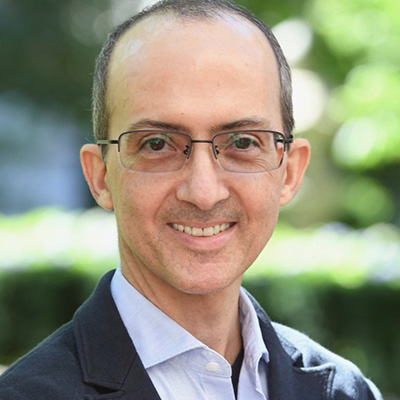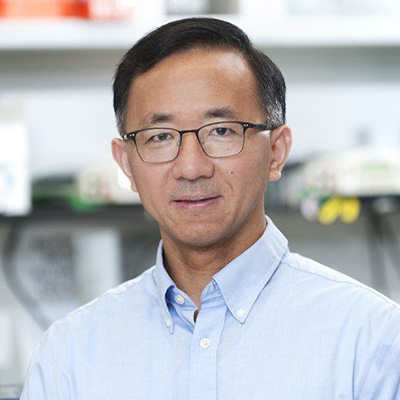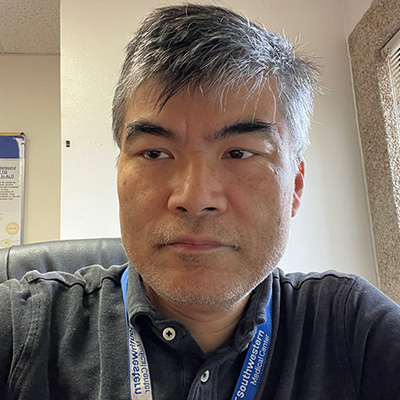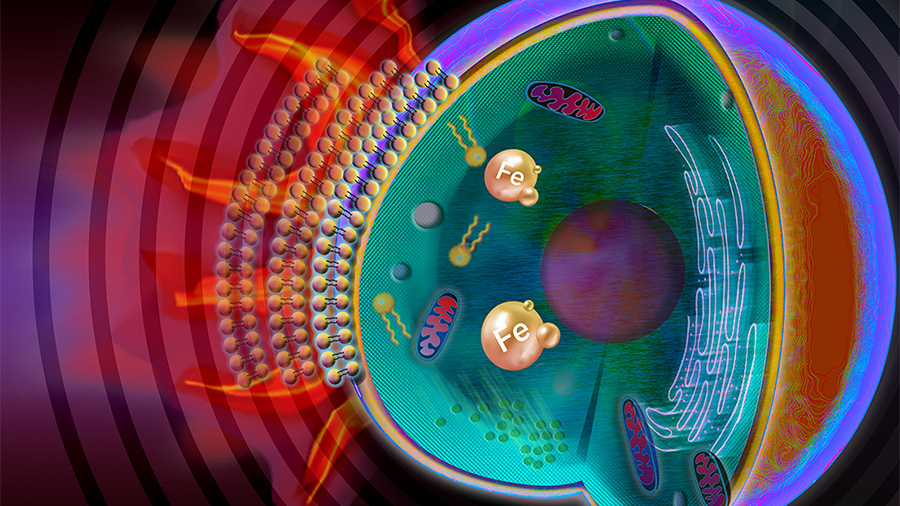Join the pioneers of ferroptosis at cell death conference
Scientists will gather in Chicago to discuss a unique form of cell death driven by iron-dependent accumulation of lipid peroxides during the American Society for Biochemistry and Molecular Biology's Ferroptosis conference.
The meeting, to be held April 13–15, concurrent with the 2025 ASBMB Annual Meeting, will focus on the role of ferroptosis in the cross talk between metabolism and biochemical homeostasis.



ASBMB Today talked to the meeting’s organizers about hot topics in ferroptosis, why they chose this metabolism-centric approach, and what they hope attendees will get out of it.
Brent Stockwell is the chair of biological sciences and a professor of pathology and cell biology and chemistry at Columbia University. His lab uses small organic molecules in a systematic way to perturb cellular processes and discover their underlying mechanisms. Stockwell discovered ferroptosis and is particularly interested in understanding cell death mechanisms and how they intersect with diseases, such as cancer and neurodegeneration.
Xuejun Jiang is a professor and member of the cell biology department at the Memorial Sloan Kettering Cancer Center. His lab focuses on the mechanisms of apoptosis, ferroptosis and autophagy, as well as their role in cancer progression and treatment.
Jin Ye is a professor of molecular genetics at the University of Texas Southwestern Medical Center. His lab investigates how lipid-mediated signaling affects ferroptosis, and how ferroptosis contributes to the development of human diseases.
Introduce yourself and tell me about how you got interested in ferroptosis.
Stockwell: My research involves ferroptosis, metabolism and their relationships with different diseases. Starting in 2003, after about nine years of research, we discovered a new kind of cell death mechanism that we termed ferroptosis. We started collaborating with Xuejun (Jiang) and others to organize meetings and bring together a community of people who find ferroptosis relevant in many areas of biology. Others have found this process in a wide variety of biological systems, even in prior studies going back to the 1950s.
Now, we continue to look at ferroptosis mechanisms and therapeutic relevance through a variety of projects in the lab. There are more than 14,000 papers published on ferroptosis now. That number has been growing exponentially. So, I'm hoping it stops soon because it's getting hard to read all the papers.
Jiang: My lab studies the mechanisms behind and disease implications of cell death. About 15 years ago, a series of our observations – like a perfect storm – led us to this unexpected cell death modality we now call ferroptosis. To make a very long story short, we started with apoptosis and autophagy in cancer. We think, under certain biological contexts, autophagy, a stress-responsive survival mechanism, can also promote cell death. These studies brought us to a very peculiar, weird type of cell death, which we figured out was ferroptosis. So, we continue to study ferroptosis, its metabolic nature, its regulation, prevention and ways to exploit it as a potential cancer therapy.
Ye: My experience is completely different from these two pioneers in ferroptosis. I'm a latecomer. I never dreamed that I’d be working on cell death. I spent decades trying to understand lipid metabolism, particularly fatty acid metabolism.
So long story short, my lab was interested in a protein that binds polyunsaturated fatty acids and wanted to know its function. One day, we knocked out this protein, and then we couldn’t do any experiments because, when we added a polyunsaturated fatty acid to the cells, they just died. At that time, I was brainwashed to think it was apoptosis. But, sure enough, it was ferroptosis.
There’s a lot of criticism out there about ferroptosis, and many people think it’s physiologically irrelevant. So, I made my contribution to the field by identifying a marker for ferroptosis. Using this marker, we determined that alcoholic liver disease and nonalcoholic liver disease are caused by ferroptosis. Now, with this marker, everybody can study whether ferroptosis is relevant in their system.
This is the first ASBMB-sponsored ferroptosis meeting. How will it be different from previous meetings?
Stockwell: It's really exciting to be working with ASBMB because this meeting brings together the molecular biology and biochemistry community to look at ferroptosis, metabolism and cell death. We are looking forward to exploring a new audience. We’ve had a few meetings with Cold Spring Harbor in Asia, but now we want to expand into different communities. So, the three of us got together, put in the proposal, and we were very pleased that it was supported by ASBMB.
Ye: We asked ASBMB to sponsor the meeting because the organization has people who are interested in lipid metabolism, iron metals, selenium metals, redox regulation, protein translational modifications, disease, cancer chemotherapy and cancer immunotherapy. The list just goes on and on. So, we can expand our community by partnering with such a broad organization.
Jiang: There’s still a lot of suspicion around whether ferroptosis is physiologically relevant. Beyond a doubt, I know it is and agree this suspicion is reasonable. But, we want to open this conversation with researchers outside of the ferroptosis field because they will help to answer these questions. I think that the community is growing, and it's quite exciting. And a lot of people, for some reason or another, have found out that ferroptosis is relevant to what they are studying.
Can you tell me about the benefit of this meeting being coordinated with the ASBMB Annual Meeting?
Stockwell: I’m hoping there will be some synergy. We will catch people going to the ASBMB Annual Meeting and vice versa. Maybe some people have made an observation in the lab that they think may be ferroptosis, but they aren’t ready to commit to a ferroptosis meeting. If there's one right down the hallway, they may just pop in, listen to a talk or go ask someone questions during lunch.
We also hope some ferroptosis attendees will get exposed to the ASBMB meeting and consider signing up to attend next year. I’m really hoping we get that kind of cross talk between the meetings.
What are your goals for this meeting?
Stockwell: We want to emphasize networking and building collaborations between different groups. A lot of the time, we find that people just stumbled on ferroptosis who’ve never attended a meeting. We want them to ask questions as well as learn the right tools and approaches. I think this is a great meeting for people who are new to the field.
Jiang: As we’ve mentioned, one of our goals is to broaden the field so that ferroptosis research becomes more visible. We want people studying biology to start thinking about how ferroptosis may contribute to their biological questions.
What can you tell me about the 2025 meeting thus far? Do you have a theme?
Stockwell: So far, we have 18 speakers in a range of different areas of ferroptosis, such as basic mechanisms, disease and metabolism. The speakers are also from various parts of the world and different professional career areas. The theme of the meeting is cross talk between metabolism and biochemical homeostasis. Again, the theme tries to bring people in with an interest in basic biochemical molecular biology and metabolism.
Ye: We have seasoned researchers speaking. But we also have a few speakers who are new to the field, who started their research in a different area and came later to the ferroptosis field. We are excited to learn a lot from the speakers. When we selected them, we tried to balance junior faculty and established faculty. We have also left open ample spots for graduate students and postdocs to give short talks. I anticipate that we are going to get quite a few abstract submissions.
Jiang: It has been very difficult for us to come up with a list because the field is exploding. There are so many outstanding investigators. But I think we put together a very exciting speaker list.
What are some of the hottest topics in ferroptosis right now that you hope to cover?
Stockwell: I think we're seeing two big movements. One is this movement into disease. We now have molecular markers to take a patient sample and see if there is ferroptosis happening in that tissue. This area is exciting because it could open up completely new therapeutic strategies. The second movement is looking at normal physiology where ferroptosis is happening to control things like tumors.
Jiang: I think another area that is very exciting in the field is the cross talk between ferroptosis and immunity, especially in the context of cancer. Will ferroptotic cell death of tumor cells engage antitumor immunity? This is most likely to be very context dependent. Another exciting area is the role of ferroptosis in neurodegeneration.
How’s it been working together?
Jiang: If you look at our recent publications, you see Brent’s (Stockwell) name and my name appear together a on lot of papers. We collaborate a lot — not just on writing reviews, but also on research articles. So, we really help and support each other. I think this is very important. We not only talk about our own research, but we also talk about the ferroptosis field in general. How can we contribute to the field? How can we benefit the research community with meetings and other things?
I'm really happy Jin (Ye) joined us recently. He contributes to our discussions in a unique way. Also, Jin and I have known each other for many, many, many years. We actually came from the same university back in China, and we joined the same graduate school, UT Southwestern.
Stockwell: I think you will also get this feeling of collaboration and camaraderie at the meeting. Other meetings can be stiff and less supportive. But I think because we have these good, strong relationships among the three of us, you'll see that manifested in the meeting. It'll be a great meeting for people to come in and meet a lot of the key players in this field.
The abstract deadline is Feb. 18. Find more information about the speakers and sessions here.

Enjoy reading ASBMB Today?
Become a member to receive the print edition four times a year and the digital edition monthly.
Learn moreFeatured jobs
from the ASBMB career center
Get the latest from ASBMB Today
Enter your email address, and we’ll send you a weekly email with recent articles, interviews and more.
Latest in People
People highlights or most popular articles

Mydy named Purdue assistant professor
Her lab will focus on protein structure and function, enzyme mechanisms and plant natural product biosynthesis, working to characterize and engineer plant natural products for therapeutic and agricultural applications.

In memoriam: Michael J. Chamberlin
He discovered RNA polymerase and was an ASBMB member for nearly 60 years.

Building the blueprint to block HIV
Wesley Sundquist will present his work on the HIV capsid and revolutionary drug, Lenacapavir, at the ASBMB Annual Meeting, March 7–10, in Maryland.

In memoriam: Alan G. Goodridge
He made pioneering discoveries on lipid metabolism and was an ASBMB member since 1971.

Alrubaye wins research and teaching awards
He was honored at the NACTA 2025 conference for the Educator Award and at the U of A State and National Awards reception for the Faculty Gold Medal.

Designing life’s building blocks with AI
Tanja Kortemme, a professor at the University of California, San Francisco, will discuss her research using computational biology to engineer proteins at the 2026 ASBMB Annual Meeting.

